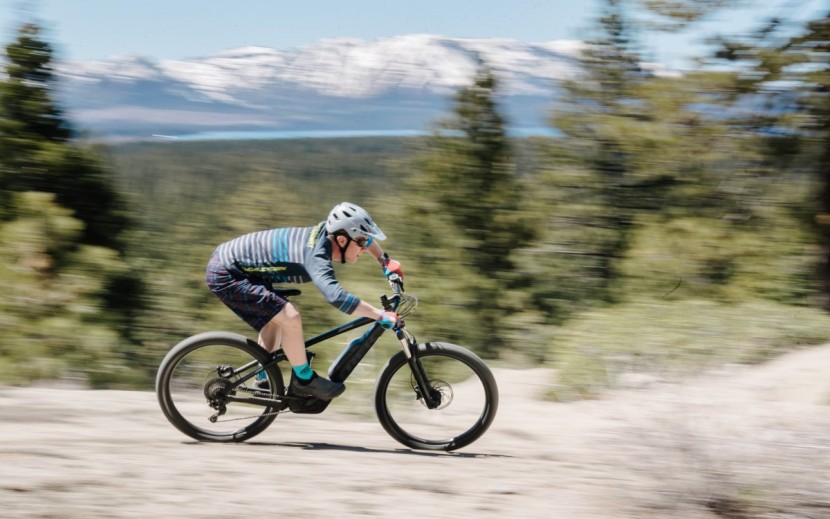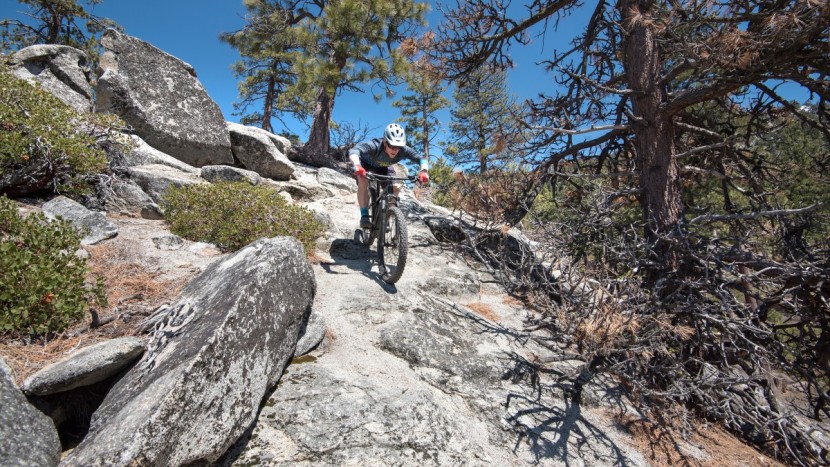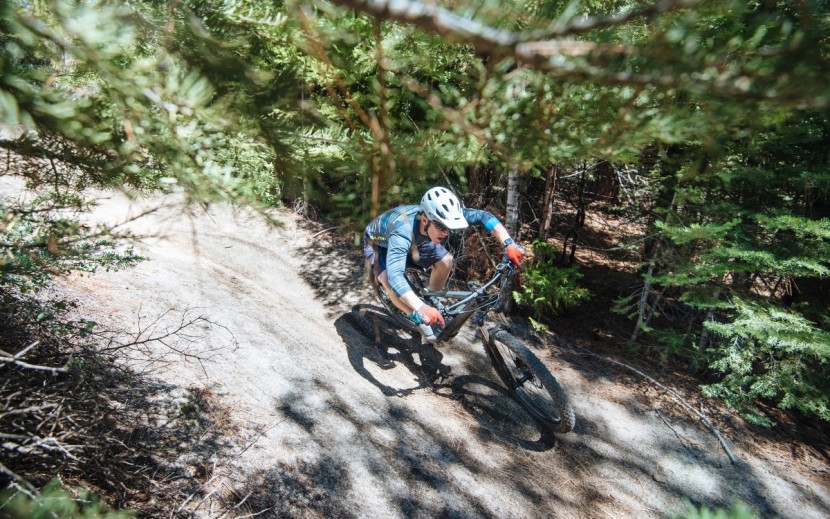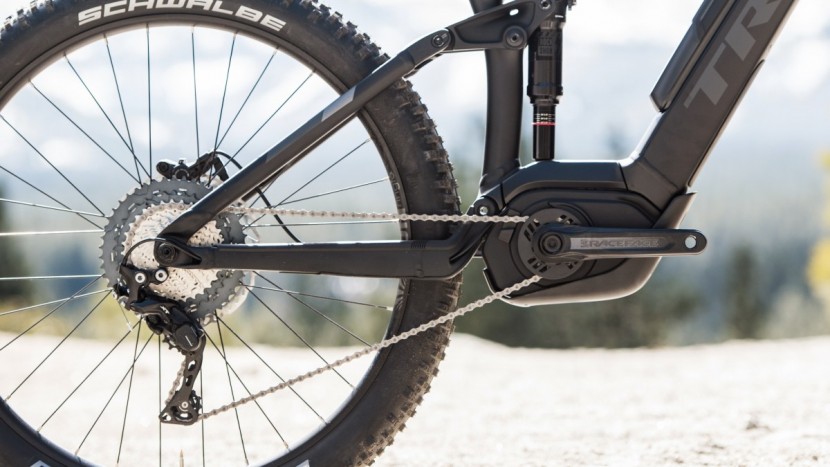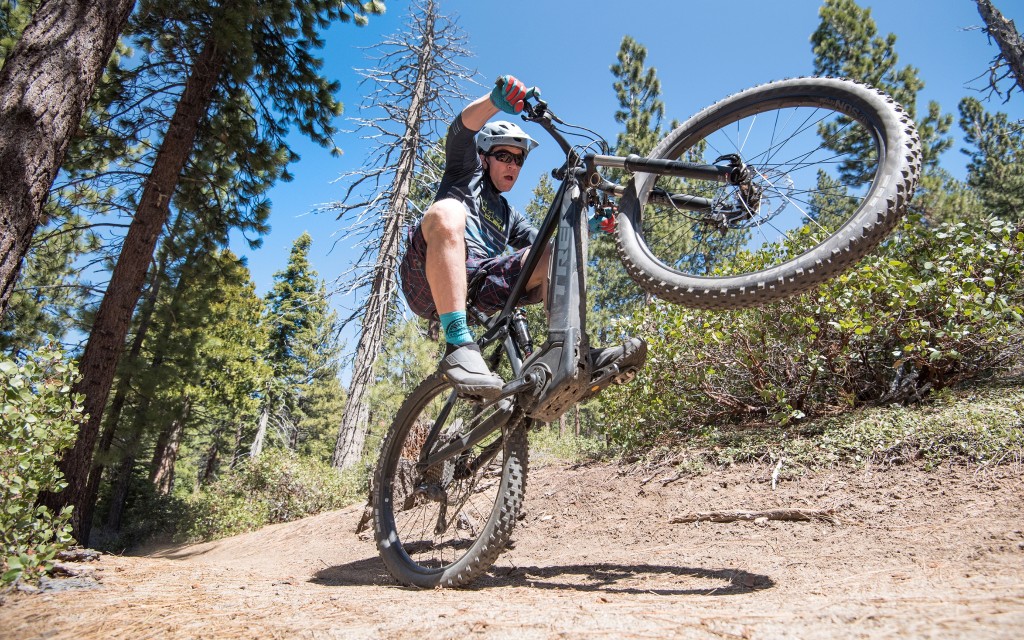Trek Powerfly 7 FS Plus Review

Our Verdict
Our Analysis and Test Results
Trek is one of the biggest brands in cycling, so it's no surprise that they have joined the manufacturers selling electric mountain bikes in North America. Over the years we've grown to expect quality from Trek that typically comes at a premium price, and the Powerfly 7 FS is an example of that. At a retail price of $5,200, this bike costs roughly the same as the other bikes in this review, give or take a few hundred dollars, but it has a build that is completely out-classed by the competition. Trek's frame design is great with a nicely integrated battery and drive unit that provides strong power output and solid distance range, but this bike's lower end components, most notably the suspension and brakes, are a serious detriment to its otherwise relatively good performance. Read on to find out how the Powerfly 7 FS compared to the competition.
E-Bike Controls
Trek has chosen Bosch for their e-bike batteries, drive units, and controls. The Bosch Purion control unit on the Powerfly 7 FS features a digital display and shifter buttons that are a single unit located on the handlebar by the left grip, similar to that found on the Bulls bike. The digital display is large and easy to read; it shows your current speed, power output setting, and remaining battery life. Its location on the left side of the handlebar made it slightly less convenient to view than the display on the Ghost Hybride SL AMR, but at lower speeds, it was still easy to view at a glance.
The shifter buttons are located on the left side of the display with large up and down buttons that shift through the Bosch drive unit's four support settings, Eco, Tour, e-MTB, and Turbo. The buttons are large and intuitive to use, but testers didn't love the ergonomics of the system and felt it was somewhat less user-friendly than the shifting found on the Bulls E-Stream, and the Specialized Turbo Levo. The buttons were large, but you had to be sure to press them directly in the center and get a positive click to be sure the drive unit would shift.
Our testers did like the charging interface on the battery unit of the Powerfly. The charging port was well protected, and the connection with the plug felt very secure. The battery charged in a similar amount of time as the competition, about 3 hours.
Downhill Performance
It would be unfair to say that the Powerfly 7 FS wasn't fun to ride downhill because it was still a blast, it just couldn't compete with the impressive downhill capabilities of the competition. There are a few reasons why, and we'll start with the bike's geometry. First, it has 130mm of front and rear wheel travel, making it more of a mid-travel bike than the other e-MTB's in our test selection. Next, it has the steepest head tube angle, at 67.3 degrees, of all the bikes we tested, which made it feel a bit less confident in steeper and rockier terrain. The size medium Trek we tested also had the longest reach, at 458mm, and the longest wheelbase, at 1226mm, of all the models in our test. This length did give it a stable and planted feeling at speed on smoother sections of trail, but it also made the bike feel sluggish and unwieldy in technical sections, tighter turns, and lower speeds.
The component specification of the Powerfly 7 FS is probably the most significant detriment to its downhill performance. The Rock Shox Recon RL Solo Air fork, in particular, is not well suited to the front end of this heavyweight electric mountain bike. The Recon fork has inconsistent, sticky feeling travel and noticeable flex when riding downhill, it just doesn't feel stout enough for the weight of the bike. Recon forks are one of Rock Shox's budget models, and they only work okay on bikes that weigh half as much as the Powerfly 7 FS to begin with. The front suspension left a lot to be desired and did not inspire any confidence while descending.
The Shimano Deore M6000 brakes also didn't really cut the mustard as they felt way under-powered for a bike of this weight. A 51 pound 12-ounce bike carries some serious speed down the hill; you definitely want all the stopping power you can get to slow it down. Trek also spec'd a pair of Schwalbe Knobby Nic 27.5 x 2.8" tubeless tires on the Powerfly, and while they are nice and knobby with plenty of air volume, a bike of this nature benefits from a much more aggressive tread. The Knobby Nics provided great traction while climbing, but on the descent, they did not provide the traction or inspire the confidence our testers were looking for, especially as a front tire.
Climbing Performance
The Powerfly 7 FS was generally a competent and comfortable bike on the uphills. The bike's long wheelbase and very long chainstays, 475mm, give it a long rear end that maintained impressive traction with the rider seated. As a matter of fact, it seemed this thing could scramble up just about anything you point it up assuming you maintained your momentum. Tighter turns and technical sections of uphill felt a little sluggish on this bike, however, due to its overall length.
The power output of the Bosch drive unit was quite strong and relatively consistent, although it didn't have the most predictable initiation. Testers also noticed the power seemed to drop out for a very brief moment when shifting the rear derailleur. In general, though, the power delivery felt pretty smooth assuming you kept your pedaling cadence up.
Testers weren't wild about the drivetrain spec'd on the Powerfly 7 FS either. It wasn't the 11-speed Shimano XT rear derailleur, that has a massive range and worked flawlessly, but the 15 tooth front chainring seemed odd. We aren't entirely sure why such a small front ring would be spec'd on this bike, as the pedal assistance from the motor already gives you all the help you need. Additionally, the front chainring is hidden behind a guard on the side of the drive motor and more challenging to clean.
Power Output
The power output of the Bosch Performance CX 250 drive unit was relatively good. The power comes on strong and suddenly, although the initiation wasn't as predictable as some of the competition. You could definitely feel the torque of the motor, and popping wheelies was definitely a possibility. Like the other e-MTB's in our test, the top speed of the pedal assist motor is 20 mph, and the Powerfly 7 has no problem getting up to and holding that speed. Testers found that the power lagged momentarily between shifts of the rear derailleur, but it didn't really last long enough to disrupt your momentum or negatively impact your riding experience. The four support settings offer a good range for a variety of trail types, riding styles, and preferences, and shifting between them was generally smooth, and intuitive using the handlebar mounted shifter. It was also easy to see which support setting you're using by looking at the digital display/shifter unit on the handlebar by the left grip.
Range
The Powerfly 7 FS impressed us the most with its distance range when compared to the bikes with comparable battery storage. It may not have the best on trail performance, but in our distance range testing, we found that it uses its power quite efficiently. We were able to ride the Powerfly 7 in its highest support setting from a fully charged battery to completely depleted over a distance of 18.6 miles and 3,076 vertical feet of climbing on trail. This range was 2 miles less than the Specialized Turbo Levo FSR Comp 6Fattie. Of course, the Trek, and the other bikes in our test selection can travel farther if using a lower support setting that burns less battery power and more calories instead.
The Bulls E-Stream EVO AM 4 has a 650Wh battery, so it didn't surprise us in the least that it was able to travel much farther than the models in the test with less battery storage.
Build
As mentioned several times above, the component specification of the Powerfly 7 FS is one of the primary factors holding back its on-trail performance. Some elements of the build are great, but our testers weren't incredibly impressed considering the $5,200 price tag. The primary point of contention is the spec of a Rock Shox Recon Solo Air fork, a low-end fork on a higher end and hefty electric mountain bike. The Recon fork is typically spec'd on non-e-bikes that retail for around $2,000 and weigh around 30 pounds, and even then the performance of the fork is lackluster at best. Sure it works, but it has a sticky feeling and inconsistent stroke, limited tune-ability, and a bit of a “pogo-stick” feel to it. Testers complained that it felt flexy and simply not stout enough to be the front suspension of a bike that weighs 51 pounds and 12 ounces. It didn't inspire confidence at all, and virtually any other fork with a little more heft to it would be preferred over the Recon. The Rock Shox Deluxe RL rear shock handled its duties admirably, it performed well on bigger hits but didn't really shine through the rough chop.
For the drivetrain, Trek spec'd an 11 speed Shimano XT derailleur with an 11-46 tooth cassette. We can't complain about the performance of Shimano XT components because they work reliably and competently. Testers weren't enthusiastic about the 15 tooth front chainring, however, and questioned the use of such a small ring in the front considering the pedal assist drive unit and 11-speed cassette in the back that already offers a ton of range. This 15 tooth front ring was also hidden behind a guard that made it more difficult to clean. Overall, the drivetrain worked, but we feel that it could benefit from a different system, possibly an e-bike specific drivetrain that is optimized to work with a pedal assist motor.
The Powerfully 7 FS rolls on Bontrager hubs laced to nice wide SUNRingle DUROC 40 SL rims that pair well with the 27.5 x 2.8" Schwalbe Knobby Nic tires. In general, we feel the Knobby Nic is a good tire, and they provided excellent traction while climbing, but testers felt the rounder profile lacked the traction they wanted while descending. The more aggressive tread patterns of the tires found on the other models in our test selection provided more traction and confidence on the descents.
The cockpit of the Powerfly 7 FS consists of a 750mm wide Bontrager handlebar and a 60mm Bontrager stem. The handlebar was a reasonable width, but testers didn't love the longer stem as this bike is already very long, with the longest reach and wheelbase in the test, and could benefit from a shorter and stouter stem. The Bontrager dropper post worked well throughout our testing and featured an ergonomic 1x remote lever.
Slowing and stopping this heavyweight electric mountain bike is left to a set of Shimano Deore M6000 hydraulic disc brakes. While we can't typically complain about the consistency and reliability of Shimano's brakes, the additional weight of an e-bike really demands something a little more powerful. Overall, the build of the Powerfully 7 FS gets the job done, but this bike could seriously benefit from a beefier fork, more powerful brakes, and some more aggressive tires.
Best Applications
If you're a rider looking for an e-MTB who is less concerned with getting rowdy than you are with how long your battery charge will last, then the Powerfly 7 FS could be a good option for you. It lacks the confident downhill performance of other bikes in this test like the Bulls E-Stream EVO, or our Editors' Choice Award winner, the Specialized Turbo Levo Comp, but it does boast a good distance range. This could also be a good multi-purpose e-bike, for a rider who may use it for commuting or zipping around town, and who also wants to get out on the trail from time to time and isn't looking to push it too hard.
Value
With a retail price of $5,200, the Powerfly 7 FS costs almost $400 more than our Best Buy Award winner, the Giant Trance E+ 2 Pro. With the lackluster build and less confidence inspiring performance of the Powerfly on the trail, we don't think it is as good a value as other electric mountain bikes in this review. For serious use on the trail, we'd be inclined to spend our money elsewhere.
Conclusion
There's no doubt that the Trek Powerfly 7 FS is fun to ride. Comparatively speaking; however, it couldn't match the all-around performance offered by other models in our test selection. Most notably, the Trek's mediocre downhill performance is largely due to the bike's poor component specification that just isn't robust enough to be competitive. That said, this could be a great electric mountain bike if the build is improved, so if/when Trek makes a version with a more impressive component spec it will be worth a second look.
Other Versions and Accessories
Trek makes two models of the Powerfly FS electric mountain bike including the Powerfly 7 FS reviewed above.
The Powerfly 5 FS retails for $4,699 and features the same frame and drive unit as the Powerfly 7 FS with a slightly downgraded component specification. The Powerfly 5 has the same suspension package but features a Shimano Deore 10 speed drivetrain, Shimano BR-M315 hydraulic disc brakes, and a selection of Bontrager parts. Trek also makes a hardtail version of the Powerfly, the Powerfly 5 and Powerfly 5 Women's. Both models have a very similar build to the Powerfly 5 FS, but with a Rock Shox Judy TK Solo Air fork with 100mm of travel.





